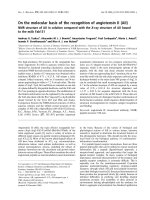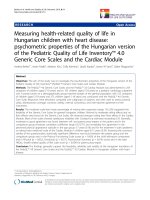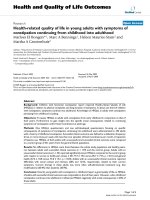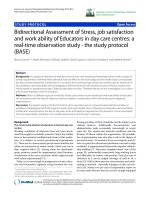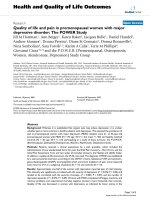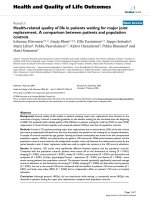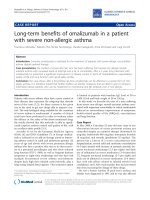Many, more, most: Four risk profles of adolescents in residential care with major psychiatric problems
Bạn đang xem bản rút gọn của tài liệu. Xem và tải ngay bản đầy đủ của tài liệu tại đây (934.46 KB, 10 trang )
Janssen‑de Ruijter et al.
Child Adolesc Psychiatry Ment Health (2017) 11:63
/>
RESEARCH ARTICLE
Child and Adolescent Psychiatry
and Mental Health
Open Access
Many, more, most: four risk profiles
of adolescents in residential care with major
psychiatric problems
Elisabeth A. W. Janssen‑de Ruijter1,2* , Eva A. Mulder3,4, Jeroen K. Vermunt5 and Chijs van Nieuwenhuizen1,2
Abstract
Background: The development of delinquent behaviour is largely determined by the presence of (multiple) risk
factors. It is essential to focus on the patterns of co-occurring risk factors in different subgroups in order to better
understand disruptive behaviour.
Aims and hypothesis: The aim of this study was to examine whether subgroups could be identified to obtain more
insight into the patterns of co-occurring risk factors in a population of adolescents in residential care. Based on the
results of prior studies, at least one subgroup with many risk factors in multiple domains and one subgroup with
primarily risk factors in a single domain were expected.
Methods: The structured assessment of violence risk in youth and the juvenile forensic profile were used to opera‑
tionalize eleven risk factors in four domains: individual, family, peer and school. Data from 270 male adolescents
admitted to a hospital for youth forensic psychiatry and orthopsychiatry in the Netherlands were available. Latent
class analysis was used to identify subgroups and significant differences between the subgroups were examined in
more detail.
Results: Based on the fit statistics and the clinical interpretability, the four-class model was chosen. The four classes
had different patterns of co-occurring risk factors, and differed in the included external variables such as psychopa‑
thology and criminal behaviour.
Conclusions: Two groups were found with many risk factors in multiple domains and two groups with fewer (but
still several) risk factors in single domains. This study shed light on the complexity of disruptive behaviour, providing a
better insight into the patterns of co-occurring risk factors in a heterogeneous population of adolescents with major
psychiatric problems admitted to residential care.
Keywords: Disruptive behaviour, Risk factors, Latent class analysis, Forensic psychiatry
Background
The development and persistence of delinquent behaviour in youth is largely determined by the presence of
(multiple) risk factors. Most research in youth forensic psychiatry has focused on which risk factors predict
delinquency and how (persistent) delinquent behaviour
in youth can be prevented [1–3]. These studies suggest
*Correspondence:
1
GGzE Centre for Child & Adolescent Psychiatry, PO BOX 909 (DP 8001),
5600 AX Eindhoven, The Netherlands
Full list of author information is available at the end of the article
that interventions that focus on delinquency must be
aimed at reducing risk factors, in line with the risk-needresponsivity model (RNR-model) of Andrews and Bonta
[4]. This model describes that the intensity of treatment
should be adjusted to the nature, extent and severity
of the problems. In addition to the nature, extent and
severity of the risk factors, insight into the patterns of
co-occurring risk factors is relevant to the treatment of
this high-risk youth, because the interaction of multiple
risk factors may influence treatment outcomes. Furthermore, studying the co-occurrence of risk factors in youth
with major psychiatric problems manifesting behavioural
© The Author(s) 2017. This article is distributed under the terms of the Creative Commons Attribution 4.0 International License
( which permits unrestricted use, distribution, and reproduction in any medium,
provided you give appropriate credit to the original author(s) and the source, provide a link to the Creative Commons license,
and indicate if changes were made. The Creative Commons Public Domain Dedication waiver ( />publicdomain/zero/1.0/) applies to the data made available in this article, unless otherwise stated.
Janssen‑de Ruijter et al. Child Adolesc Psychiatry Ment Health (2017) 11:63
maladjustment, could gain more insight into the complexity of disruptive and delinquent behaviour.
In many studies on the development of delinquent
behaviour, risk factors are divided into different domains:
the individual, family, peer and school domains [2, 3, 5].
Examples of risk factors for delinquency are low IQ and
prior history of substance use in the individual domain
[3, 5, 6], exposure to violence in the home and parental criminality in the family domain [2, 3, 5, 7, 8], peer
rejection and delinquent peers in the peer domain [3, 5,
6, 9] and low academic achievement and truancy in the
school domain [2, 3, 5, 9]. Many adolescents with delinquent behaviour have multiple risk factors in numerous
domains in their lives [9].
Possible consequences of being exposed to multiple
risk factors have been described in the cumulative risk
hypothesis [10, 11]. This hypothesis implies that the
accumulation of risk factors, regardless of the presence
or absence of particular risk factors, affects developmental outcomes: the greater the number of risk factors,
the greater the prevalence of delinquent behaviour. Several studies have confirmed such a dose–response relationship between the number of risk factors and the
likelihood of delinquent behaviour [2, 3, 5, 6, 9, 12]. Furthermore, exposure to an accumulation of risk factors
in multiple domains, instead of risk factors in a single
domain, increases the chance of later negative outcomes
such as delinquent behaviour [12].
Despite the substantial number of studies on (multiple) risk factors for delinquent behaviour, little is known
about the patterns of co-occurring risk factors among
adolescents. To study the co-occurrence of risk factors,
a person-centred approach instead of a variable-centred
approach is needed. A person-centred approach examines how behaviours co-occur in groups of adolescents.
In most research with a person-centred approach, subgroups are based on specific characteristics, such as committed offences, emotional and behavioural problems, or
one single risk factor such as substance abuse [13–17].
In addition, the studies that used multiple risk factors to
find subgroups have examined specific populations, such
as childhood arrestees or first offenders [18–20]. However, studies on subgroups based on multiple risk factors
in a broad population of adolescents in residential care
are scarce.
Adolescents in residential care are a heterogeneous
population, for example concerning psychiatric problems
and exposure to risk factors [21, 22]. In addition, disruptive problem behaviour and delinquent behaviour are
quite common in this population, although the frequency
and severity of these behaviours may differ [23]. Insight
into the patterns of co-occurring risk factors is a first
step to better understanding the complexity of disruptive
Page 2 of 10
behaviour. Therefore, the aim of this study was to examine whether subgroups could be identified to obtain more
insight into the patterns of co-occurring risk factors in a
heterogeneous population of adolescents in residential
care with no, minor or serious delinquent behaviour and
major psychiatric problems. Based on the results of prior
studies on multiple risk factors, at least one subgroup
with many risk factors in multiple domains and one subgroup with primarily risk factors in a single domain were
expected [18, 19].
Methods
Setting
All participants were admitted to the Catamaran, a hospital for youth forensic psychiatry and orthopsychiatry in
the Netherlands. This secure residential care setting
offers intensive multidisciplinary treatment to male and
female patients aged between 14 and 23 years. Patients
admitted to this hospital are sentenced under juvenile
criminal law or juvenile civil law, or are admitted voluntarily. Dutch juvenile criminal law comprises the treatment and rehabilitation of adolescents1 who have
committed serious offences. Measures under the Dutch
juvenile civil law are applied to adolescents whose development is at risk and whose parents or caregivers are not
able to provide the required care. Irrespective of the type
of measure, all patients of this hospital display severe and
multiple problems in different areas of their lives.
Participants
The total sample comprised all male patients admitted to
the Catamaran with a minimal stay of 3 months between
January 2005 and July 2014 (N = 275). Because 99% of
the admitted adolescents are male, only male patients
were included. Five patients who objected to the provision of the data for research purposes were excluded
from the sample. Hence, the final sample comprised 270
patients. Of these patients, 129 were sentenced under
Dutch juvenile criminal law (47.8%) and 118 under
Dutch juvenile civil law (43.7%), while 23 patients were
admitted voluntarily (8.5%). The majority of the patients
(81.1%) were convicted of one or more offence(s) before
their admission. Moderately violent offences (50.0%) and
property offences without violence (45.2%) were the most
common. As for psychopathology, most of the DSM-IVTR disorders were in the category “disorders usually first
diagnosed in infancy, childhood, or adolescence”, in particular disruptive behaviour disorders (48.9%) and autism
spectrum disorders (42.6%). Detailed demographic characteristics are displayed in Table 1.
1
For reasons of brevity, the term ‘adolescent’ is used throughout the text to
include young adults who were sentenced under the Dutch juvenile justice
system.
Janssen‑de Ruijter et al. Child Adolesc Psychiatry Ment Health (2017) 11:63
Table 1 Demographic characteristics (N = 270)
M (SD)
Page 3 of 10
Structured assessment of violence risk in youth (SAVRY)
Range
Age at admission in years
16.9 (1.8)
14–23
IQ
93.9 (12.0)
63–127
n
%
Judicial measure
Criminal law
129
47.8
Civil law
118
43.7
Voluntary
23
8.5
No conviction
51
18.9
Drug offence
12
4.4
Vandalism (property)
83
30.7
Previous delinquent behavioura
Property offence without violence
122
45.2
Moderate violent offence
135
50.0
Violent property offence
53
19.6
Serious violent offence
21
7.8
Sex offence
36
13.3
Manslaughter
9
3.3
Arson
2
0.7
Murder
7
2.6
Axis-I classification of DSM-IV-TRb,c
Disruptive behaviour disorder
132
48.9
Autism spectrum disorder
115
42.6
Attention deficit/hyperactivity
disorder
63
23.3
Substance disorder
61
22.6
Reactive attachment disorder
34
12.6
Schizophrenia or other psychotic
disorder
25
9.3
Mood disorder
23
8.5
Anxiety disorder
22
8.1
Other disorder usually first diag‑
nosed in infancy, childhood, or
adolescence
19
7.0
Other disordersd
18
6.7
Personality disorder
16
5.9
Mental retardation
16
5.9
Axis-II classification of DSM-IV-TRb
a
Classification of Van Kordelaar [28]
b
Only DSM-IV-TR classifications with a prevalence of > 5% are displayed
c
Due to comorbidity, percentages of DSM-IV-TR classifications do not sum up
to 100
d
Other disorders are sexual and gender identity disorders, sleep disorders,
impulse control disorders not elsewhere classified, and adjustment disorders
Data collection
Data were collected through the structured assessment
of violence risk in youth, the juvenile forensic profile and
structured file analysis.
The SAVRY [24] is a risk assessment tool based on the
structured professional judgement model. The SAVRY
consists of 24 risk items and six protective items. The risk
items have three coding possibilities (low, moderate and
high), whereas the protective items are scored on a twopoint scale (present or absent). The inter-rater reliability
of the SAVRY risk total score is good and the predictive
validity for physical violence against persons is excellent
[24, 25].
Juvenile forensic profile (JFP)
The JFP [26] has been developed to measure risk factors
in all life areas and for all types of offending behaviour
using file data. The instrument contains seventy risk factors pertaining to seven domains: history of criminal
behaviour, family and environment, offence-related risk
factors and substance use, psychological factors, psychopathology, social behaviour/interpersonal relationships,
and behaviour during stay at the institution. Each risk
factor is measured on a three-point scale, where 0 = no
problems, 1 = some problems, and 2 = severe problems.
The inter-rater reliability of the JFP and the convergent
validity, measured by SAVRY, were of satisfactory quality [26]. The predictive validity of the JFP was tested in a
sample of 102 boys. A total score from nine risk factors
of the JFP was found to be a good predictor of recidivism
(AUC of 0.80; [27]).
Structured file analysis
Structured file analysis was used to register objective
characteristics of the patients’ lives. These characteristics
included general background information (for example,
ethnicity), life events, DSM-IV-TR classifications and
committed offences. The committed offences were classified in accordance with the classification by Van Kordelaar ([28]; as used in [17]) and the life events were based
on the ‘Life Events’ scoring list from a Dutch monitor system for youth health [29].
Data preparation
In this study, risk factors that were present at the moment
of admission to the hospital were used to identify distinct
subgroups. Therefore, eleven risk factors within the four
domains (individual, family, peer and school), which were
often described in the literature as prominent risk factors
for disruptive problem behaviour or delinquency, were
chosen. The best appropriate items of the SAVRY and JFP
were used to operationalize these eleven risk factors.
The individual domain consisted of three risk factors:
hyperactivity (item 43 of the JFP), cognitive impairment
Janssen‑de Ruijter et al. Child Adolesc Psychiatry Ment Health (2017) 11:63
Page 4 of 10
(item 39 of the JFP) and history of drug abuse (item 42 of
the JFP). The family domain contained three risk factors:
exposure to violence in the home (item 6 of the SAVRY),
childhood history of maltreatment (item 7 of the SAVRY)
and criminal behaviour of family members (item 14 of
the JFP). The three risk factors in the peer domain were
peer rejection (item 10 of the JFP), involvement in criminal environment (item 13 of the JFP) and lack of secondary network (item 55b of the JFP). The school domain
comprised two risk factors: low academic achievement
(item 25 of the JFP) and truancy (item 22 of the JFP).
After the identification of the different subgroups, possible differences between the subgroups were examined.
For this, the objective characteristics from the file analysis and two age variables of the JFP (age of first criminal
behaviour/violent behaviour) were used.
patient is only permitted under three conditions: (1) the
study is of general interest; (2) the study cannot be conducted without the requested information; and (3) the
participant has not expressly objected to the provision of
the data. This study fits within the conditions of this law,
as the data were collected retrospectively. For an extra
check, this type of study has been discussed thoroughly
and approved by the science committee of the GGzE
and by the Ethics Review Board of Tilburg University. In
this study, patients’ anonymity was guaranteed by using
research numbers instead of names. Five patients in the
initial sample (N = 275) explicitly objected to the provision of the data for research purposes and were therefore
excluded. Hence, this study was conducted in accordance
with the prevailing medical ethics in the Netherlands.
Procedure
Latent class analysis (LCA) by means of Latent GOLD
5.0 [30, 31] was used to construct a clustering of latent
classes based on a set of categorical latent variables [32].
In LCA, the following three steps were used: (1) a latent
class model was built using the eleven risk factors as indicators; (2) subjects were assigned to latent classes based
on their posterior class membership probabilities; and (3)
the relationship between class membership and external
variables was investigated [33].
In the first step, a latent class model was built with
eleven ordinal risk factors as indicators. Of these factors,
ten risk factors used a three-point scale: 0 (no risk), 1 (a
small risk) and 2 (a high risk), and the eleventh risk factor
(cognitive impairment) was recoded into a dichotomous
variable (IQ less than or equal to 85 versus higher than
85). To identify the most suitable number of classes, several model fit indices were used. Firstly, the complexity of
the latent class model was considered using three information criteria: the Bayesian information criterion (BIC),
the Aikake information criterion (AIC) and the Aikake
information criterion 3 (AIC3; [32, 34–37]). These criteria weight the fit and the parsimony of a model: the criteria are lowest for the best model. Secondly, a bootstrap
likelihood ratio test (BLRT; [38]) was used to compare
two models—for example, the three-class model with the
four-class model. A significant p value (p < .05) rejects
the null hypothesis that the three-class model, in this
example, holds in the population.
In step two, the subjects were assigned to latent classes
based on their posterior class membership probabilities.
The classification method was a proportional assignment,
which means that subjects were assigned to each class
with a weight equal to the posterior membership probability for that class [32].
In the last step (step three), the association between
class membership and external variables was investigated.
Scoring of the SAVRY and JFP was done by officially
trained and certified researchers and trainees under
supervision. All instruments were completed by means
of consensus scoring until an inter-rater reliability of at
least 80% was achieved. After reaching an inter-rater reliability of at least 80%, the certified researchers scored
individually. The trainees who were not officially trained
remained under the supervision of a trained researcher,
which means that each SAVRY and JFP they scored was
checked by a trained researcher. The procedure scoring
the structured file analysis was identical: after achieving
an inter-rater reliability of at least 80%, the researchers
scored individually and the trainees remained under the
supervision of a researcher.
Scoring of the historical items of the SAVRY and JFP
and the structured file analysis took place simultaneously 3 months after admission of the patient. At that
time, all the required documents had been collected and
the patient files were (mostly) complete. Risk factors, life
events and other variables before admission were scored
using information from all possible sources before admission, such as diagnostic reports from psychologists and
psychiatrists, criminal records, treatment plans from
previous settings and juridical documents. DSM-IV-TR
classifications, demographic information and admission
characteristics were collected from registration files and
the first treatment plan of the Catamaran. All information was processed anonymously.
The Dutch Law on Medical Treatment Agreement
Article 7: 458 states that scientific research is permitted
without the consent of the patient if an active informed
consent is not reasonably possible or, given the type and
aim of the study, may not be required. The anonymity of
the patient must be ensured using coded data. In addition, scientific research without the active consent of the
Statistical analyses
Janssen‑de Ruijter et al. Child Adolesc Psychiatry Ment Health (2017) 11:63
For this purpose, the BCH method for continuous data
[39] and the maximum likelihood (ML) procedure for
nominal data [40] were used. Wald tests were used to
determine the significance (p < .05) of the encountered
differences between classes in external variables (e.g. life
events and committed offences). The significance tests
are mainly used to eliminate the variables which are
of less interest rather than to prove which effects really
exist. Therefore, the alpha level is not adjusted for multiple testing (e.g. using a Bonferroni correction of a factor 53) since much stricter alpha levels would potentially
hide possibly interesting correlates of the encountered
classes.
Results
LCA
Table 2 shows the model fit statistics for models between
one and eight latent classes. For the optimal modelling
of the data, the information criteria suggest a range of
a three-class model (BIC) to a seven-class model (AIC).
The AIC3, which is the suitable criterion to use in small
samples [34], is lowest for the four-class model. The p values of the BLRT were significant up to and including the
four-class model. This means that the four-class model
was preferred over the three-class model (BLRT = 44.44,
p < .000). Therefore, the four-class solution was chosen,
which was also in line with the clinical interpretability of
the classes.
Class description
The means of the risk factors in the individual, family,
peer and school domains for each of the four classes on a
zero to one scale are shown in Fig. 1. Table 3 shows significant differences between the four classes on all risk factors except for hyperactivity, cognitive impairment and
low academic achievement. Class 1 (n = 119, 44% of sample) represented adolescents with risk factors in the individual domain (drug abuse), peer domain (involvement in
criminal environment) and school domain (truancy). In
Page 5 of 10
addition, adolescents in Class 2 (n = 70, 26% of sample)
had risk factors in all four domains, such as drug abuse,
childhood history of maltreatment and lack of a secondary network. In contrast, adolescents in Class 3 (n = 49,
18% of sample) had the lowest risks overall. Notably, they
had the highest risk for peer rejection compared to the
adolescents in other classes. Finally, Class 4 (n = 32) represented the smallest group of adolescents (12% of sample). Risk factors that were common in this group were
exposure to violence in the home and childhood history
of maltreatment in the family domain.
Profiling the classes
To further describe the four classes, differences between
the classes concerning the demographic and admission
characteristics, psychopathology, drug use, criminal
behaviour and life events were studied (see Additional
file 1). The following variables were significantly different between the classes: judicial measure, age at admission, ethnicity and earliest age of (outpatient) care.
More specifically, there were more first and second
generation immigrants in Class 2 than in Classes 1 and
3 (Wald = 13.70, p = .003). The majority of adolescents
in Class 2 were placed under the Dutch juvenile criminal law, whereas the majority of adolescents in Class 4
were placed under the Dutch civil law (Wald = 16.09,
p = .013). In addition, adolescents in Class 4 had the earliest age of (outpatient) care (mean = 6.8; Wald = 8.33,
p = .040) and were youngest at admission to the Catamaran (mean = 15.6; Wald = 24.44, p = .000).
As for psychopathology, the following disorders differed significantly between the classes: disruptive behaviour disorder, autism spectrum disorder, substance
disorder, reactive attachment disorder and schizophrenia or other psychotic disorder. Adolescents in Classes
1 and 2 were, compared to adolescents in Classes 3 and
4, more often diagnosed with a disruptive behaviour
disorder (Wald = 11.37, p = .010), a substance disorder
(Wald = 194.67, p = .000), and schizophrenia or other
Table 2 Model fit statistics for latent classes
1-class
2-class
3-class
4-class
5-class
6-class
7-class
8-class
LL
BIC
AIC
AIC3
− 2444.22
No. of para-meters
p value BLRT
Entropy R2
5006.02
4930.45
4951.45
21
− 2396.34
4977.42
4858.67
4891.67
33
.000
1.00
.67
− 2359.75
4971.42
4809.49
4854.49
45
.000
.68
− 2337.52
4994.16
4789.05
4846.05
57
.000
.71
− 2322.49
5031.28
4782.99
4851.99
69
.064
.73
− 2308.20
5069.88
4778.41
4859.41
81
.168
.73
− 2294.16
5108.97
4774.32
4867.32
93
.116
.75
− 2282.86
5153.56
4775.72
4880.72
105
.296
.76
LL log likelihood, BIC Bayesian information criterion, AIC Aikake information criterion, AIC3 Aikake information criterion 3, BLRT bootstrap likelihood ratio test
Janssen‑de Ruijter et al. Child Adolesc Psychiatry Ment Health (2017) 11:63
1.00
0.90
0.80
0.70
0.60
0.50
0.40
0.30
Class 1
0.20
Class 2
Class 3
0.10
Class 4
Individual
Peer
Truancy
Low academic achievement
Lack of secondary network
Peer rejecƟon
Family
Involvement in criminal
environment
Criminal behavior of family
Exposure to violence
Physical/emoƟonal abuse
Drug abuse
CogniƟve impairment
HyperacƟvity
0.00
School
Fig. 1 Four-class class solution (N = 270)
psychotic disorder (Wald = 103.47, p = .000). Furthermore, autism spectrum disorders were more common in
adolescents in Classes 1 and 3 (Wald = 28.64, p = .000),
and reactive attachment disorders were more common in
adolescents in Classes 2 and 4 (Wald = 15.83, p = .001).
In addition, substance use differed significantly between
the classes—soft drug use (Wald = 49.64, p = .000),
hard drug use (Wald = 214.33, p = .000) and alcohol use
(Wald = 41.83, p = .000)—and was more common in
adolescents in Classes 1 and 2.
With regard to criminal behaviour, there were significant differences in no previous offences, vandalism, property offences without violence, moderate violent offences,
violent property offences, serious violent offences, sex
offences, arson and murder. Most types of offence—for
example, property offences and violent offences—were
Page 6 of 10
more common in adolescents in Classes 1 and 2 than in
adolescents in Classes 3 and 4. Sex offences were, however, more common in adolescents in Class 3 (44.1%;
Wald = 21.37, p = .000). Adolescents in Class 4 most
often had no previous offences (53.1%; Wald = 18.03,
p = .000).
Life events that differed significantly between the
classes in the individual domain were victim of discrimination, financial problems, being a refugee from another
country and out-of-home placement. For example, outof-home placement before admission was more common
in adolescents in Class 4 (82.4%; Wald = 11.42, p = .010).
In addition, in the family domain, the following life
events were significant: chronic illness or hospitalization
of brother/sister, drug abuse parents, psychopathology
parents, divorced parents, problems with new parent(s),
financial problems parents and deceased brother/sister.
Most of these life events in the family were more common in Classes 2 and 4 than in adolescents in Classes 1
and 3. Furthermore, two life events in the peer domain
were significant: victim of bullying was most common in
adolescents in Class 3 (86.1%; Wald = 18.10, p = .000),
and impregnated a girl was more common in Classes
2 and 4 (respectively 2.2 and 10.2%; Wald = 19.03,
p = .000).
Summary of the classes
Based on the risk factors of the first step of the LCA, two
subgroups with many risk factors in multiple domains
and two subgroups with fewer risk factors in single
domains were found. Firstly, the adolescents in the classes
with many risk factors (Classes 1 and 2), were mostly
similar in respect of the types of offence they committed,
except for the higher number of (attempted) murders in
Class 2. In addition, the prevalence of psychopathology
and substance use was also similar in both classes, except
Table 3 Means and comparison of LCA variables across four classes (N = 270)
Risk factors
Overall mean
Class 1
(n = 119)
Hyperactivity
Class 2
(n = 70)
Class 3
(n = 49)
Class 4
(n = 32)
Wald
p
Post hoc
1.03
1.14
.80
.97
1.25
5.59
.140
–
Cognitive impairment
.24
.27
.30
.21
.01
1.79
.620
–
History of drug abuse
1.12
1.51
1.46
.18
.47
26.88
.000
1,2 > 3,4
Exposure to violence in the home
.43
.14
.82
.08
1.32
26.01
.000
2,4 > 1; 4 > 3
Childhood history of maltreatment
.74
.19
1.55
.22
1.78
14.06
.003
2,4 > 1,3
Criminal behaviour of family members
.44
.17
1.00
.17
.61
21.47
.000
2,4 > 1; 2 > 3
Peer rejection
.72
.55
.72
1.31
.40
16.40
.001
3 > 1,2,4
Involvement in criminal environment
.78
.95
1.30
.04
.31
23.76
.000
1,2 > 3,4; 2 > 1
Lack of secondary network
1.38
1.27
1.82
1.30
.95
13.01
.005
2 > 1,3,4
Low academic achievement
.54
.55
.39
.71
.58
31.9
.36
–
1.42
1.67
1.41
.95
1.25
15.81
.001
1,2 > 3; 1 > 4
Truancy
Janssen‑de Ruijter et al. Child Adolesc Psychiatry Ment Health (2017) 11:63
for the higher prevalence of reactive attachment disorder in Class 2. Alternatively, the main difference between
these two classes was the high family risk in Class 2.
Other differences were ethnicity (more immigrants in
Class 2) and financial problems (higher prevalence in
Class 2).
The other two subgroups comprised adolescents with
fewer, but still several, risk factors in single domains.
The risk factors in these two subgroups were very different: adolescents in Class 3 experienced mainly risks in
the peer domain, whereas adolescents in Class 4 experienced mainly family risks. Furthermore, adolescents in
these two classes also differed in terms of psychopathology (highest prevalence of autism spectrum disorders in
Class 3 versus highest prevalence of reactive attachment
disorders in Class 4) and committed offences (the highest
prevalence of sex offences in Class 3 versus the highest
percentage of no previous conviction in Class 4).
Discussion
In this study, subgroups were investigated in a sample of
adolescents in residential care with no, minor or serious
delinquent behaviour and major psychiatric problems.
The aim of this study was to obtain more insight into
the patterns of co-occurring risk factors in order to better understand disruptive problem behaviour. Four subgroups were identified based on eleven risk factors in
the individual, family, peer and school domains: Class 1
with many risk factors in the individual, peer and school
domains; Class 2 with many risks in all four domains;
Class 3 with mainly risks in the peer domain; and Class
4 with mainly risks in the family domain. These results
were largely in line with the hypotheses, identifying not
one but two subgroups with many risk factors and also
not one but two subgroups with fewer risk factors in single domains.
As for the relationship between class membership and
previous delinquent behaviour, this study, like many
other studies, supports the cumulative risk hypothesis
[10, 11]. Adolescents in the two groups with many risk
factors had more often committed multiple offences than
adolescents in the other two groups. Adolescents in the
two groups with fewer, but still several, risk factors also
had a history of delinquent behaviour. However, this
behaviour was slightly less frequent than that of adolescents with more risk factors. This finding corresponds
with a recent study by Wong et al. [9], who found a linear relationship between the accumulative risk level and
delinquency: delinquent boys and girls turned out to have
higher risk levels than boys and girls without delinquent
behaviour.
Those adolescents in the two groups with many risk
factors (Classes 1 and 2) have a similar history of criminal
Page 7 of 10
behaviour. The combination of committed offences and
experienced risk factors in these two classes corresponds
with the characteristics of the subgroup violent property offenders found by Mulder et al. [17]. This subgroup
consisted of high-frequency offenders with violent and
property offences, highest scores on alcohol abuse and
high scores for conduct disorder, involvement with criminal peers, criminal behaviour in the family and truancy.
Despite the similarities of the classes with this subgroup
of violent property offenders, it is remarkable that the
current study distinguished not one but two separate
classes with one main difference.
The main difference between Classes 1 and 2 is the high
number of family risk factors in Class 2, which is in line
with the results of Geluk and colleagues [19]. They found
an externalizing intermediate problem group that was
characterized by externalizing problems in the individual
and peer domains and relatively few parenting problems,
and a pervasive high problem group with many problems
across all domains. The results of this study on childhood
arrestees who committed a first offence under the age of
12 imply that the classification of two separate groups
based on the presence or absence of risks in the family
domain can also be found in childhood.
Risk factors in the family domain were also seen in adolescents in Class 4 with childhood history of maltreatment as the highest family risk factor. In the literature,
an association between maltreatment and later (violent) delinquency was found [41–43]. The pattern that
abused children themselves commit violence or delinquent behaviour later in life is described as “the Cycle
of Violence” [44, 45]. Bender [46] proposed an extension of this cycle with potential intervening risk factors
in order to answer the question of why some maltreated
youths become juvenile offenders. She found a potential
intervention of two factors for males, namely running
away from home and association with deviant peers. The
association with deviant peers, which mainly occurred
in adolescents in Class 2, could possibly explain why the
adolescents in Class 2 were more often involved in criminal behaviour than those in Class 4.
Class 3 is a specific class with distinctive risk factors
and characteristics different from the other classes. Adolescents in this class were most often diagnosed with an
autism spectrum disorder, had the highest risk for peer
rejection, and committed sexual offences more often
compared to the other classes. The coincidence of an
autism spectrum disorder and peer rejection is in line
with the literature, which describes that children with
autism spectrum disorders have an increased risk of
being victims of bullying [47–49]. In addition, the highest prevalence of sexual offences in this class corresponds
with a study by ’t Hart-Kerkhoffs et al. [50] who found
Janssen‑de Ruijter et al. Child Adolesc Psychiatry Ment Health (2017) 11:63
higher levels of symptoms of autism spectrum disorder in
juvenile suspects of sex offences compared with the nondelinquent population. Furthermore, in a review by Van
Wijk et al. [51], a relationship was mentioned between
peer relationship problems and sexual offences, both of
which were present in this group of adolescents.
Strengths of this study include the use of a reasonably large and complex clinical sample and a sophisticated approach to identifying heterogeneous clusters of
youths. Nevertheless, there are also limitations to consider. Firstly, a limitation of this study is the use of file
information to gather data. In most cases, the files were
complete with corresponding information from various
sources. However, in some cases, information from different sources was inconsistent. In these cases, additional
information about the patient and/or his parents would
have been very useful. Although the structured file analysis and scoring of the SAVRY and JFP was thoroughly
conducted with all available information, only 4% of the
files were double coded in order to achieve an inter-rater
reliability of 80%. However, given the small differences
between the raters in the training phase (range 68–88%),
we concluded that the individually scored cases were
reliable scored. Another limitation to consider is that of
the generalizability of the findings. Our sample of male
patients was admitted to one hospital for youth forensic psychiatry and orthopsychiatry in the Netherlands,
which of course calls into question the generalizability of
the findings. However, since the Catamaran offers treatment to a specific group of adolescents with major psychiatric problems from all over the country, this sample
might well be representative of the population of adolescents with major psychiatric problems and behavioural
problems in the Netherlands.
Despite these limitations, the findings of this study
may have implications for practice. The risk, needs, and
responsivity principles of the RNR-model [4] are important to take into account. First, according to the risk principle, more intensive treatment should be provided to
persons with a risk profile with higher risks (adolescents
in Classes 1 and 2) than to persons with a risk profile
with lower risks (adolescents in Classes 3 and 4). Second,
according to the needs principle, interventions should
focus on the criminogenic needs of a person, which can
be found in the described risk factors of each subgroup.
For example, in adolescents in Classes 2 and 4 with high
family risks interventions that strengthen protective factors in the family system could be valuable, because in
past research protective factors were found to neutralize risk factors [2, 52]. Third, regarding responsivity,
interventions must be adapted to the responsivity of the
adolescents, which in this study is provided by information concerning cognitive functioning and low academic
Page 8 of 10
achievement in the past. Hence, intervention decisions
based on these three principles should finally lead to a
reduction of recidivism [4].
In conclusion, this study underscores the importance of
person-centred research using multiple risk factors and
provides a better insight into the patterns of co-occurring
risk factors in a heterogeneous population of adolescents in residential care with major psychiatric problems.
Obviously, future research on these subgroups is needed,
but this study is a first step towards a better understanding of the complexity of disruptive behaviour in this population of adolescents in residential care.
Additional file
Additional file 1: Table S1. Differences between the classes in demo‑
graphic and admission characteristics. Table S2. Differences between
the classes in psychopathology and substance use. Table S3. Differences
between the classes in criminal behaviour and Table S4. Differences
between the classes in life events.
Authors’ contributions
ChvN and EJ were responsible for the study concept and design. EJ was
responsible for the acquisition and collection of the data. JV and EJ analysed
and interpreted the data in collaboration with EM and ChvN. EJ was a major
contributor in writing the manuscript. EM and ChvN were involved in critically
revising the work. All authors read and approved the final manuscript.
Author details
1
GGzE Centre for Child & Adolescent Psychiatry, PO BOX 909 (DP 8001), 5600
AX Eindhoven, The Netherlands. 2 Scientific Center for Care & Welfare (Tranzo),
Tilburg University, Tilburg, The Netherlands. 3 Leiden University Medical Center,
Leiden, The Netherlands. 4 Intermetzo-Pluryn, Nijmegen, The Netherlands.
5
Department of Methodology and Statistics, Tilburg University, Tilburg, The
Netherlands.
Acknowledgements
We thank Marloes van Lierop, Meddy Weijmans and Marilyn Peeters for their
help in the data collection. We also thank Ilja Bongers for her advice during
the preparation of this manuscript.
Competing interests
The authors declare that they have no competing interests.
Availability of data and materials
The datasets analysed during the current study are not publicly available due
to intellectual property rights but are available from the corresponding author
on reasonable request.
Consent for publication
Not applicable.
Ethics approval and consent to participate
All procedures performed in studies involving human participants were in
accordance with the ethical standards of the institutional and/or national
research committee and with the 1964 Helsinki declaration and its later
amendments or comparable ethical standards. This study was in accordance
with the Dutch Law on Medical Treatment Agreement, article 7: 458, which
states that scientific research is permitted without the consent of the patient
if an active informed consent is not reasonably possible or, given the type and
aim of the study, may not be required.
Funding
This study was facilitated by GGzE Centre for Child & Adolescent Psychiatry.
Janssen‑de Ruijter et al. Child Adolesc Psychiatry Ment Health (2017) 11:63
Publisher’s Note
Springer Nature remains neutral with regard to jurisdictional claims in pub‑
lished maps and institutional affiliations.
Received: 9 June 2017 Accepted: 7 December 2017
References
1. Farrington DP. Developmental and life-course criminology: key theoreti‑
cal and empirical issues. The 2002 Sutherland Award Address. Criminol‑
ogy. 2003. />2. Van der Laan AM, Veenstra R, Bogaerts S, Verhulst FC, Ormel J. Serious,
minor, and non-delinquents in early adolescence: the impact of cumula‑
tive risk and promotive factors. The TRAILS study. J Abnorm Child Psychol.
2010. />3. Loeber R, Slot NW, Stouthamer-Loeber M. A cumulative developmental
model of risk and promotive factors. In: Loeber R, Slot NW, Van der Laan
AM, Hoeve M, editors. Tomorrow’s criminals. The development of child
delinquency and effective interventions. Farnham: Ashgate; 2008. p.
133–61.
4. Andrews DA, Bonta J. The psychology of criminal conduct. 5th ed. New
Provence: Matthew Bender & Company, Inc., LexisNexis Group; 2010.
5. Murray J, Farrington DP. Risk factors for conduct disorder and delin‑
quency: key findings from longitudinal studies. Can J Psychiatry.
2010;55(10):633–42.
6. Johansson P, Kempf-Leonard K. A gender-specific pathway to seri‑
ous, violent, and chronic offending? Exploring Howell’s risk fac‑
tors for serious delinquency. Crime Delinquency. 2009. https://doi.
org/10.1177//0011128708330652.
7. Hoeve M, Semon Dubas J, Eichelsheim VI, Van der Laan PH, Smeenk
W, Gerris JRM. The relationship between parenting and delinquency: a
meta-analysis. J Abnorm Child Psychol. 2009. />s10802-009-9310-8.
8. Wong TML. Girls delinquency. A study on sex differences in (risk factors
for) delinquency [Doctoral dissertation]. Vrije Universiteit Amsterdam;
2012.
9. Wong TML, Loeber R, Slotboom A, Bijleveld CCJH, Hipwell AE, Stepps SD,
Koot HM. Sex and age differences in the risk threshold for delinquency. J
Abnorm Child Psychol. 2013. />10. Rutter M. Protective factors in children’s responses to stress and disadvan‑
tage. In: Kent MW, Rolf JE, editors. Primary prevention of psychopathol‑
ogy, vol 3: social competence in children. Hanover: University of New
England Press; 1979. p. 49–74.
11. Sameroff AJ. Dialectical processes in developmental psychopathology.
In: Sameroff A, Lewis M, Miller S, editors. Handbook of developmental
psychopathology. 2nd ed. New York: Kluwer Academic/Plenum Publish‑
ers; 2000. p. 23–40.
12. Loeber R, Burke JD, Pardini DA. Development and etiology of disrup‑
tive and delinquent behavior. Annu Rev Clin Psychol. 2009. https://doi.
org/10.1146/annurev.clinpsy.032408.153631.
13. DeLisi M, Vaughn MG, Salas-Wright CP, Jennings WG. Drugged and
dangerous: prevalence and variants of substance use comorbidity
among seriously violent offenders in the United States. J Drug Issues.
2015;45(3):232–48.
14. Hasking PA, Scheier LM, Abdallah A. The three latent classes of adolescent
delinquency and the risk factors for membership in each class. Aggress
Behav. 2011;37:19–35.
15. Vaughn MG, DeLisi M, Gunter T, Fu Q, Beaver KM, Perron BE, Howard MO.
The severe 5%: a latent class analysis of the externalizing behavior spec‑
trum in the United States. J Crim Justice. 2011. />crimjus2010.12.001.
16. Bianchi V, Brambilla P, Garzitto M, Colombo P, Fornasari L, Bellina M,
Bonivento C. Latent classes of emotional and behavioural problems
in epidemiological and referred samples and their relations to DSM-IV
diagnoses. Eur Child Adolesc Psychiatry. 2017. />s00787-016-0918-2.
Page 9 of 10
17. Mulder EA, Vermunt JK, Brand EFJM, Bullens R, Van Marle H. Recidivism in
subgroups of serious juvenile offenders: different profiles, different risks?
Crim Behav Ment Health. 2012. />18. Dembo R, Wareham J, Poythress N, Meyers K, Schmeidler J. Psycho‑
social functioning problems over time among high-risk youths. A
latent class transition analysis. Crime Delinquency. 2008. https://doi.
org/10.1177/0011128707306016.
19. Geluk CAML, Van Domburgh L, Doreleijers TAH, Jansen LMC, Bouw‑
meester S, Garre FG, Vermeiren R. Identifying children at risk of problem‑
atic development: latent clusters among childhood arrestees. J Abnorm
Child Psychol. 2013. />20. Schwalbe CS, Macy RJ, Day SH, Fraser MW. Classifying offend‑
ers: an application of latent class analysis to needs assessment
in juvenile justice. Youth Violence Juv Justice. 2008. https://doi.
org/10.1177/1541204007313383.
21. Yampolskaya S, Mowery D, Dollard N. Profile of children placed in resi‑
dential psychiatric program: association with delinquency, involuntary
mental health commitment, and reentry into care. Am J Orthopsychiatry.
2014. />22. Yampolskaya S, Mowery D. Profiles of youth in therapeutic group care:
associations with involuntary psychiatric examinations and readmissions.
Am J Orthopsychiatry. 2017. />23. Dölitzsch C, Schmid M, Keller F, Besier T, Fegert JM, Schmeck K, Kölch M.
Professional caregiver’s knowledge of self-reported delinquency in an
adolescent sample in Swiss youth welfare and juvenile justice institutions.
Int J Law Psychiatry. 2016. />24. Lodewijks HPB, Doreleijers TAH, De Ruiter C, De Wit-Grouls HF. SAVRY.
Handleiding voor de gestructureerde risicotaxatie van gewelddadig
gedrag bij jongeren [SAVRY. Manual for the structured assessment of
violence risk in youth]. Zutphen: Rentray; 2006.
25. Lodewijks HPB, Doreleijers TAH, De Ruiter C, Borum R. Predictive validity
of the structured assessment of violence risk in youth (SAVRY) during
residential treatment. Int J Law Psychiatry. 2008. />ijlp.2008.04.2009.
26. Brand EFJM, Van Heerde WK, Handleiding FPJ. Forensisch profiel justitiële
jeugdigen [Scoring manual JFP-list. Juvenile forensic profile]. The Hague:
Department of Justice, National Agency of Correctional Institutions; 2010.
27. Brand EFJM. Onderzoeksrapport PIJ-dossiers 2003C: Predictieve validiteit
van de FPJ-lijst [Research study PIJ-files 2003C: predictive validity of the
JFP-list]. The Hague: Department of Justice, National Agency of Correc‑
tional Institutions; 2005.
28. Van Kordelaar WFJM. BOOG. Beslissingsondersteuning onderzoek
geestvermogens in het strafrecht voor volwassenen. Een forensisch
psychologische studie [Decision support in research on mental ability in
criminal law. A forensic psychological study]. Deventer: Kluwer; 2002.
29. RIVM. Indicatoren voor de Monitor Jeugdgezondheid. Ingrijpende
gebeurtenissen 1219 vragenlijst kind. [Indicators of the Monitor Youth
Health. Life events 1219 questionnaire child]. 2005. i‑
torgezondheid.nl/jeugdindicatoren.aspx. Accessed 13 June 2011.
30. Vermunt JK, Magidson J. Latent GOLD 4.0 user’s guide. Belmont: Statisti‑
cal Innovations Inc; 2005.
31. Vermunt JK, Magidson J. Latent GOLD 5.0 upgrade manual. Belmont:
Statistical Innovations Inc; 2013.
32. Vermunt JK, Magidson J. Technical guide for latent GOLD 5.0: basic,
advanced, and syntax. Belmont: Statistical Innovations Inc; 2013.
33. Bakk Z, Tekle FB, Vermunt JK. Estimating the association between
latent class membership and external variables using bias-adjusted
three-step approaches. Sociol Methodol. 2013. https://doi.
org/10.1177/0081175012470644.
34. Andrews RL, Currim IS. A comparison of segment retention criteria for
finite mixture logit models. J Mark Res. 2003. />jmkr.40.2.235.19225.
35. Bozdogan H. Choosing the number of component clusters in the
mixture-model using a new informational complexity criterion of the
inverse-Fisher information matrix. In: Opitz O, Lausen B, Klar R, editors.
Information and classification, concepts, methods and applications.
Berlin: Springer; 1993. p. 40–52.
36. Dias JG. Finite mixture models: review, applications, and computer inten‑
sive methods. Groningen: Rijksuniversiteit Groningen; 2004.
Janssen‑de Ruijter et al. Child Adolesc Psychiatry Ment Health (2017) 11:63
37. Lukociene O, Varriale R, Vermunt JK. The simultaneous decision(s)
about the number of lower- and higher-level classes in mul‑
tilevel latent class analysis. Sociol Methodol. 2010. https://doi.
org/10.1111/j.1467-9531.2010.01231.x.
38. Langeheine R, Pannekoek J, Van De Pol F. Bootstrapping goodness-of-fit
measures in categorical data analysis. Sociol Methods Res. 1996. https://
doi.org/10.1177/0049124196024004004.
39. Bolck A, Croon MA, Hagenaars JA. Estimating latent structure models
with categorical variables: one-step versus three-step estimators. Polit
Anal. 2004;12:3–27.
40. Vermunt JK. Latent class modeling with covariates: two improved threestep approaches. Polit Anal. 2010;18:450–69.
41. Lansford JE, Miller-Johnson S, Berlin LJ, Dodge KA, Bates JE, Pettit GS. Early
physical abuse and later violent delinquency: a prospective longitudinal
study. Child Maltreat. 2007. />42. Mersky JP, Reynolds AJ. Child matreatment and violent delinquency:
disentangling main effects and subgroup effects. Child Maltreat. 2007.
/>43. Salzinger S, Rosario M, Feldman RS. Physical child abuse and ado‑
lescent violent delinquency: the mediating and moderating
roles of personal relationships. Child Maltreat. 2007. https://doi.
org/10.1177/1077559507301839.
44. Widom CS. The cycle of violence. Science. 1989;244:160–6.
45. Widom CS, Maxfield MG. An update on the “cycle of violence”. Wash‑
ington DC: US Department of Justice, Office of Justice Programs 2001,
National Institute of Justice; 2001.
Page 10 of 10
46. Bender K. Why do some maltreated youth become juvenile offenders? A
call for further investigation and adaptation of youth services. Child Youth
Serv Rev. 2010. />47. Zablotsky B, Bradshaw CP, Anderson C, Law PA. The association between
bullying and the psychological functioning of children with autism
spectrum disorders. J Dev Behav Pediatr. 2013. />DBP.0b013e31827a7c3a.
48. Zablotsky B, Bradshaw CP, Anderson CM, Law PA. Risk factors for bullying
among children with autism spectrum disorders. Autism. 2014. https://
doi.org/10.1177/1362361313477920.
49. Zeedyk SM, Rodriguez G, Lipton LA, Baker BL, Blacher J. Bullying of
youth with autism spectrum disorder, intellectual disability, or typical
development: victim and parent perspectives. Res Autism Spectr Disord.
2014;8(9):1173–83.
50. ’t Hart-Kerkhoffs LA, Jansen LM, Doreleijers TA, Vermeiren R, Minderaa RB,
Hartman CA. Autism spectrum disorder symptoms in juvenile suspects of
sex offenses. J Clin Psychiatry. 2009;70:266–72.
51. Van Wijk A, Vermeiren R, Loeber R, ‘t Hart-Kerkhoffs L, Doreleijers T, Bul‑
lens R. Juvenile sex offenders compared to non-sex offenders: a review
of the literature 1995–2005. Trauma Violence Abuse. 2006. https://doi.
org/10.1177/1524838006292519.
52. De Vries Robbé M, Geers MCK, Stapel M, Hilterman ELB, Vogel V. SAP‑
ROF—Youth Version Dutch. Richtlijnen voor het beoordelen van bescher‑
mende factoren voor gewelddadig gedrag bij jeugd. [Guidelines for the
assessment of protective factors for violence risk in juveniles]. Utrecht: De
Forensische Zorgspecialisten; 2014.
Submit your next manuscript to BioMed Central
and we will help you at every step:
• We accept pre-submission inquiries
• Our selector tool helps you to find the most relevant journal
• We provide round the clock customer support
• Convenient online submission
• Thorough peer review
• Inclusion in PubMed and all major indexing services
• Maximum visibility for your research
Submit your manuscript at
www.biomedcentral.com/submit
